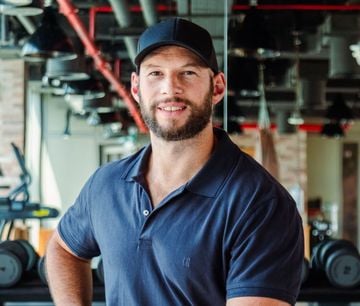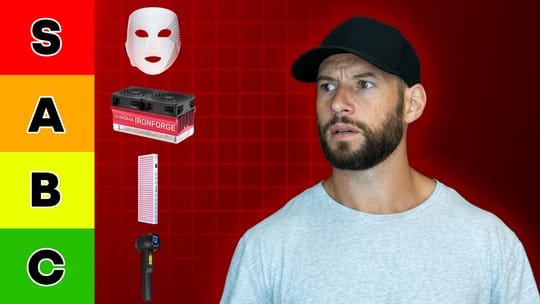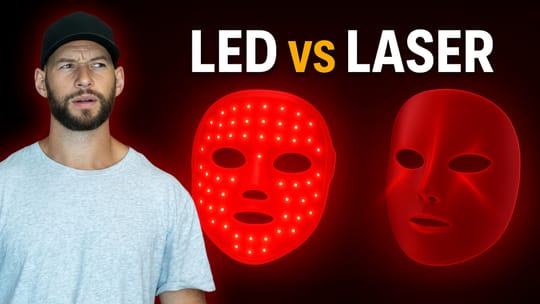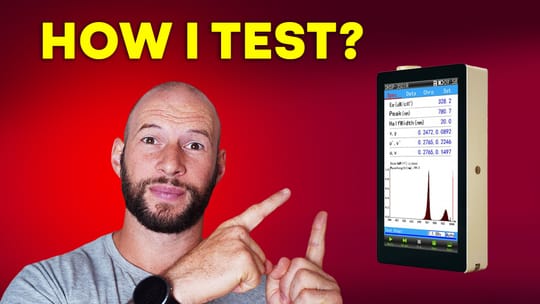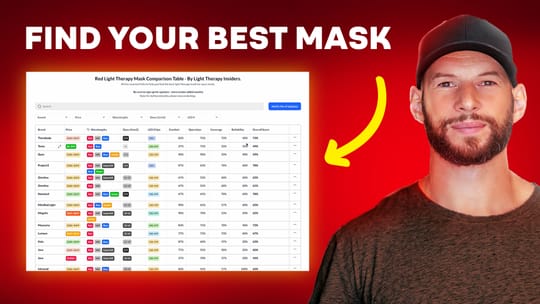This article comprises two related experiments.
1) Red Light Therapy Treatment Area + Beam Angle Confusion?
2) Red Light Therapy Treatment Area: Do Bigger Panels Give Better Light Coverage?
Red Light Therapy Treatment Area + Beam Angle Confusion?
Recently, I shared a video where I tested the impact a mirror had on a red light therapy panel. What I discovered during that test surprised me. The light didn’t spread outward from the LEDs in the way I had always assumed. Instead, it stayed rather tight and focused directly in front of the diodes.
This threw me off because I’ve answered countless questions from people over the years who wanted to know if a narrow panel would still provide coverage across their shoulders. I always thought the answer was yes—that as you stepped back, the light spread outward and widened its coverage. But after that mirror experiment, I started to question whether I’d been wrong all along.
So today I set out to test this properly, using five different panels, each with varying beam angles and designs. My goal was to shine them against a blank wall, measure their actual spread, and see once and for all if beam angle really dictates coverage.
The Setup: Panels and Beam Angles
For this test, I used:
- Rouge Care Pro (30-degree beam angle)
- Mito Red MitoPro 1500 (60-degree beam angle)
- An older Mito Red “Mito Mid” panel (also 60-degree)
- PlatinumLED BioMax 900 (90-degree beam angle)
- Joovv panel
I wanted to make sure these panels represented a spread across the common beam angles used in red light therapy—30, 60, and 90 degrees.
My method was simple: I set each panel 60 centimeters (about 2 feet) from a blank wall. First, I measured the actual width of the LEDs on the panel itself. Then I turned it on and measured the width of the light coverage on the wall. In theory, the further you are from the panel, the wider the spread should be. But would reality line up with theory?
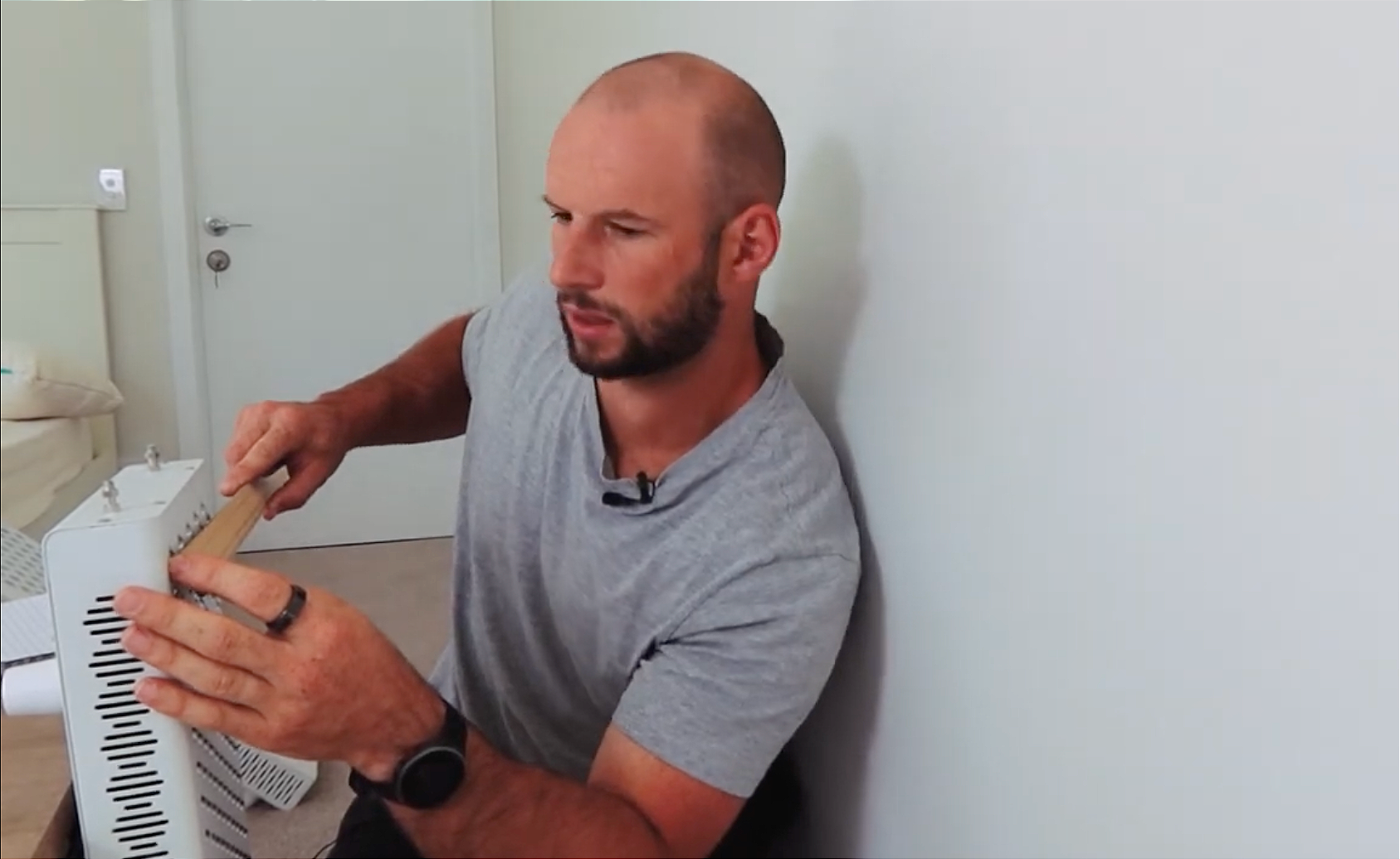
Rouge Pro (30-Degree Beam Angle)
The Rouge Pro panel measured 16 cm (6.3 in) wide across its LEDs.
When I turned it on at 60 cm from the wall, the spread on the wall was about 50 cm (19.69 in) wide. The focused, brighter zone measured closer to 38 cm (14.96 in) across, but overall, there was definitely visible light extending well beyond the original 16 cm panel width.
To put that into perspective, a standard book I had nearby measured 19 cm (7.48 in) wide, so the Rouge was clearly casting light far beyond the diode spacing.
This confirmed that at least some spread was happening.
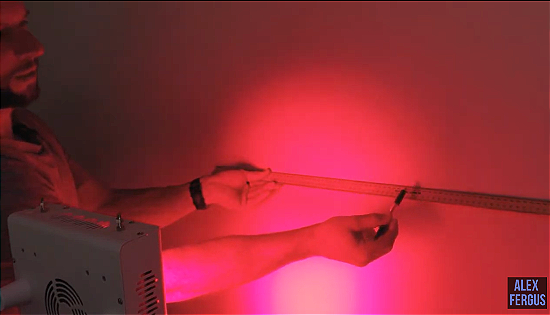
Mito Red MitoPro 1500 (60-Degree Beam Angle)
This panel also had LED spacing of 16.5 cm.(6.50 in)
At the wall, the spread was even larger—about 59 cm(23.23 in), with a focused area again in the mid-30 cm range. This was noticeably wider than the Rouge, despite having a “tighter” 60-degree rating. Already, the theory of beam angle dictating coverage wasn’t holding up.
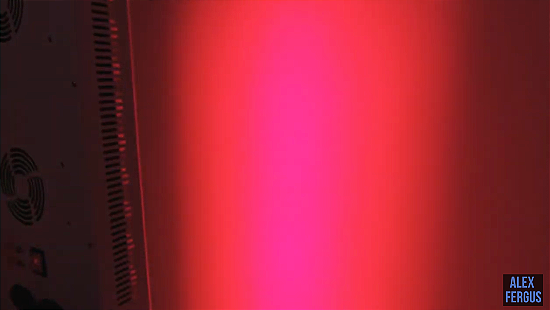
An Older Mito Red “Mono Mid” (60-Degree Beam Angle)
This smaller, older-generation panel measured 11 cm wide (4.33 in) across the LEDs.
At 60 cm (23.62 in) from the wall, its spread was again about 50 cm (19.69 inches) wide—actually wider than the Rouge, despite having fewer diodes and supposedly the same beam angle rating as the MitoPro 1500.
PlatinumLED BioMax 900 (90-Degree Beam Angle)
This one should have produced the widest spread. The LED spacing was 22 cm (8.66) across—already wider than the others.
But when I tested it against the wall, the spread was only about 45 cm(17.72 in) wide. Narrower than both Mito panels and not at all what I’d expect from a panel rated at 90 degrees.
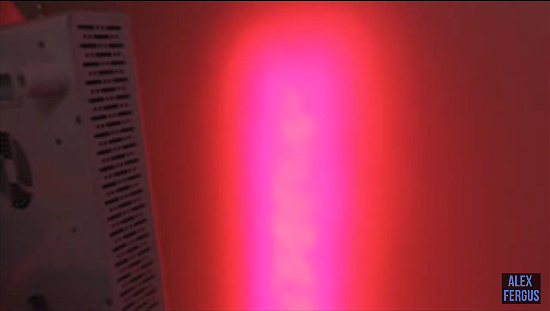
Interim Thoughts: Beam Angle Doesn’t Explain It
At this stage of testing, the results honestly made no sense.
- The Rouge Pro, with its supposed 30-degree beam angle, spread the light about 50 cm (19.7 in) across the wall.
- The Mito Red MitoPro 1500, rated for a wider 60-degree beam angle, had nearly 59 cm (23.2 in) of spread—actually wider than the Rouge.
- Then, the older Mito Red Mono Mid panel, also a 60-degree beam angle, came in at around 50 cm (19.7 in) of spread—wider than the Rouge, similar to the newer MitoPro.
But here’s where it gets really strange: the PlatinumLED BioMax 900, with its 22 cm (8.7 in) LED spacing (that’s about 6 cm / 2.4 in more than the MitoPro) and 90-degree beam angles—which in theory should have produced the widest spread of all—actually had the tightest spread of the bunch at only 45 cm (17.7 in) across.
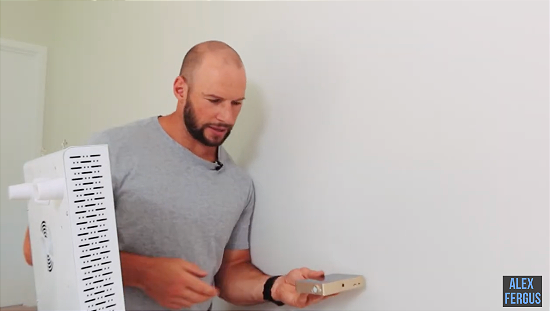
Why Treatment Distance Matters
Keep in mind that these wall tests were conducted at a distance of two feet (60 cm) away. Most people don’t stand two feet from their panel. Realistically, you’re going to be somewhere between 6 and 12 inches (15 and 30 cm) away.
At those closer distances, the coverage becomes even tighter. To put things in perspective, my shoulders measure 53 cm (20.9 in) across. Even with the BioMax at two feet (60 cm) away, I wouldn’t be getting full shoulder-to-shoulder coverage.
The MitoPro 1500 might reach my shoulders at that distance, but its focused zone was still only about 38 cm (15 in) wide—meaning my outer shoulders and arms wouldn’t be getting meaningful light. At closer, more practical distances, the problem becomes even more pronounced.
Want Help Choosing a Red Light Panel? Grab my 2025 Red Light Panel Comparison Resource.
Spectrometer Testing: Actual Power Drop-Off
Examining light coverage on the wall gives you a rough idea of the spread, but the real question is: how much therapeutic intensity actually reaches the outer areas? To answer that, I brought out my spectrometer and measured the power across the panels.
- In the center: 60 mW/cm²
- Just outside the LEDs: 15 mW/cm² (¼ of the strength)
- A few inches beyond: 4 mW/cm², then quickly to zero
Even though the wall appeared evenly lit, the therapeutic intensity was strongest right in front of the LEDs.
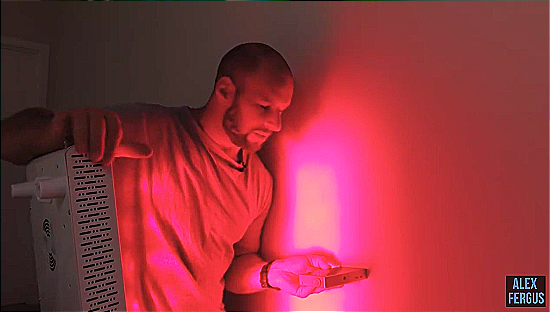
- In the center: 55–58 mW/cm²
- 1–2 inches (2.5–5 cm) outside the LEDs: mid-20s mW/cm²
- Further out: 15 mW/cm² or lower
The “spread” seen on the wall didn’t match the usable treatment intensity—the edges received very little.
- In the center: 45–46 mW/cm²
- Just outside the LEDs: low 20s
- A few inches beyond the panel (4 in / 10 cm): 10 mW/cm² or less
Same pattern. The moment you step outside the physical diode area, intensity plummets.
Another critical observation came when I moved the panels closer to the wall:
- Center intensity increased naturally
- Light spread tightened dramatically
- Edges dropped off faster, meaning even if the wall seemed illuminated, the actual therapeutic benefit outside the diode area was minimal.
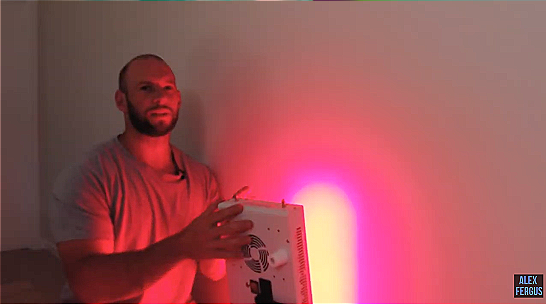
This confirmed that to receive the full effect, you really need to be positioned directly in front of the LEDs. Just a few inches off-center (2–5 in / 5–12 cm), and the power drops to a fraction of what’s in the middle, showing how critical positioning is for treatment.
Overall, these spectrometer readings reinforced my concerns: wall spread can be misleading, and therapeutic light is tightly concentrated right in front of the diodes. Even panels with wider beam angles or LED spacing show sharp drop-offs at the edges. Moving closer intensifies the center but doesn’t broaden coverage—it only shrinks the effective treatment area.
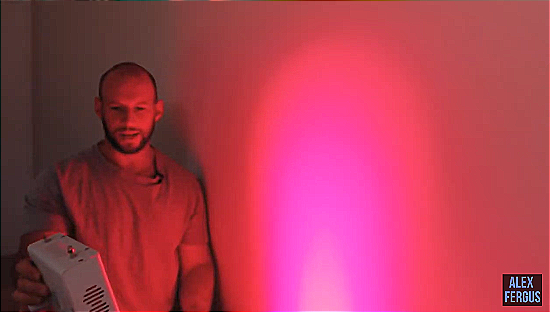
What This Means for Treatment Coverage
The key takeaway is straightforward: therapeutic strength is only available directly in front of the LEDs.
Yes, there’s light spreading out. But that light is weak—often just 10–20% of what you’re getting in the center zone.
So if you want full shoulder-to-shoulder coverage, the panel (or panels) you use need to be at least as wide as the body area you wish to treat.
For slender individuals, a single panel, such as the BioMax 900, might be sufficient. However, for most men or those with broader shoulders, one panel won’t suffice. You’ll either need two panels side by side or segmented treatments (left side, then right side).
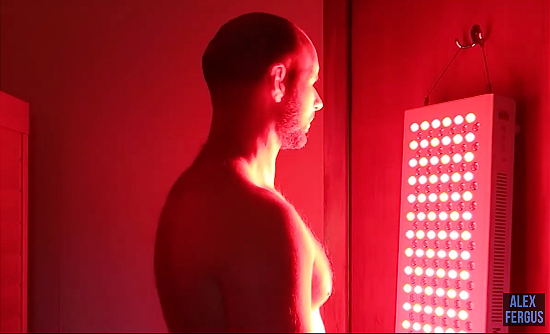
Final Thoughts:
This experiment confirmed a few things for me:
- Beam angles don’t matter in practice. The numbers don’t correlate with actual coverage.
- Light spread is misleading. The wall may look evenly covered, but therapeutic intensity drops dramatically as soon as you move outside the diode area.
- Panel width matters most. For full coverage, the panel (or set of panels) must match the width of your treatment area.
When I only had one panel years ago, I would stand in the middle, maybe sway a bit, and hope for coverage. Now, with better testing tools, I can see that the outer areas were getting very little light compared to the center.
For now, this experiment reinforced why I don’t focus on beam angle marketing claims and instead look at real-world coverage and intensity.
Items mentioned in these Articles:
✅ For a Mito Red Light Panel - use this link: https://aferg.co/7d221 - A discount is automatically applied after you click the link
✅ For a PlatinumLED panel use the following link: https://aferg.co/redled The discount appears in a popup window once you click the link.
✅ For a Rouge Pro, use discount code ALEX and this link: https://aferg.co/rougecare
Red Light Therapy Treatment Area: Do Bigger Panels Give Better Light Coverage?
What size red light therapy panel should you get? And what area does red light therapy help with? I explain both in my article below:
So, you’re shopping for a red light therapy panel and are unsure what size to get. When I say “size,” I’m not referring to the panel's width and height, but rather to the actual physical dimensions of that LED area—the width and height.
If you’re in this situation, this blog post is for you. Recently, I released a video that yielded some surprising results regarding red light panel sizes and coverage. It startled me, and judging by the feedback, it surprised many of you as well.
⬇️ ⬇️ Be sure to read the first article to see the surprising results. ⬇️ ⬇️
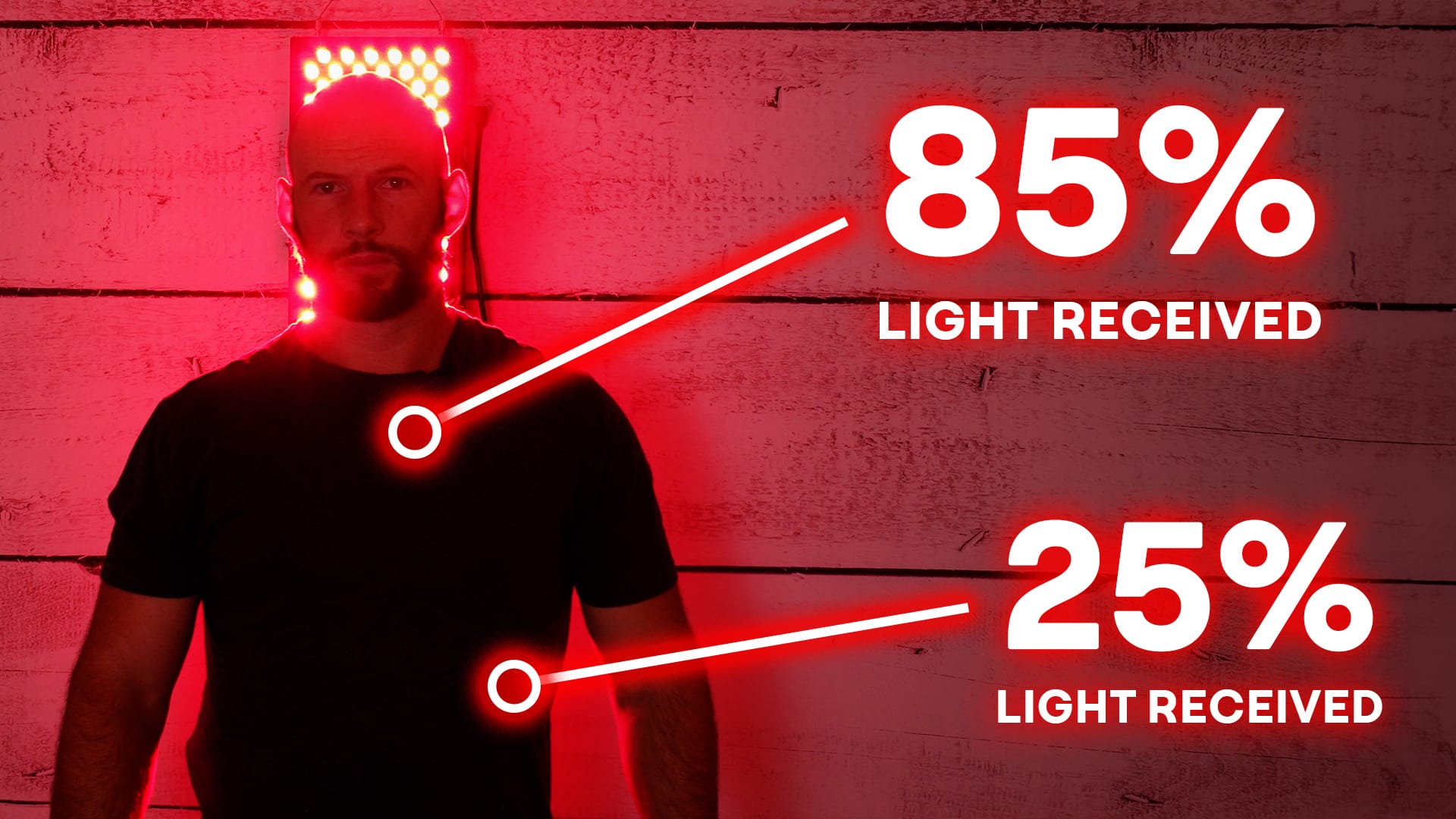
Do Smaller Red Light Therapy Panels Cover Your Whole Body?
If you’re looking for a red light therapy panel that provides full coverage from head to toe and shoulder to shoulder, can a standard 200-300 LED panel do the job? Many companies claim that standing 6 or 12 inches from the panel will give you total light saturation—even with smaller body panels.
These panels often come equipped with 200 to 300 LEDs, which sounds promising, but unfortunately, it probably won't give you the full coverage you’re looking for.
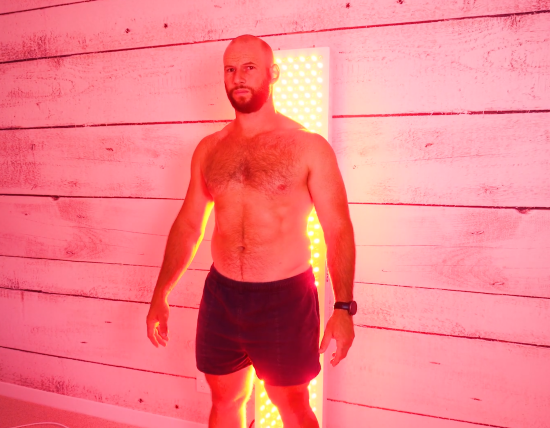
If you want full-body, high-intensity coverage, you’ll need to buy multiple body panels or invest in a large wall panel—or, even better, a red light therapy bed.
In this article, I will guide you through my setup and share some findings that may alter your approach to red light therapy.
My Red Light Therapy Setup:
For the past few years, I’ve used the PlatinumLED Biomax 900 quad setup, which comprises four BioMax 900 panels mounted together. At 5 foot 10 and well over 200 pounds, I always hoped this large setup would provide adequate light for my body—and today, I’m going to find out just how well it works. Additionally, I’ll help you understand what to look for when selecting a panel that best suits your needs.
Testing the Biomax 900 Setup:
This setup has been my go-to for quite some time, and I've been pleased with the results. To give you some context, I’m 54-55 centimeters shoulder to shoulder, and my panel setup is about the same width. However, there’s a gap in the middle between the four panels where no LEDs are present.
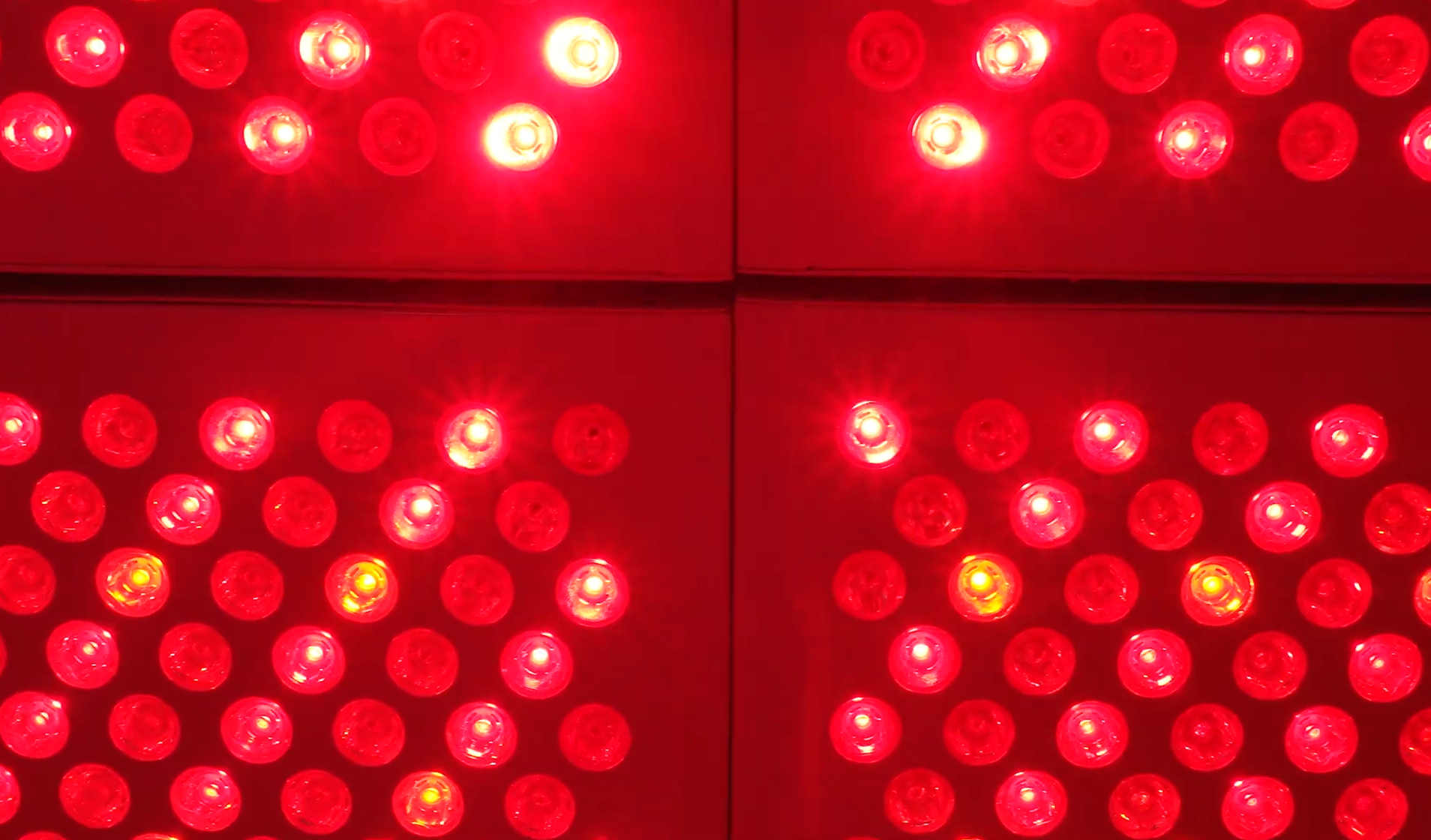
My goal today is to measure the light output at 6 inches, 12 inches, and 24 inches from the panel to see how the light spreads.
Presenting the Test Results:
To illustrate the results of our light panel test, I've set up a visual demonstration:
The Test Setup
- I've created an outline representing a person's shoulder width (let's call him Alfred).
- The outline is 55 centimeters wide, matching my own shoulder-to-shoulder measurement.
Mapping the Light Panel
- Using a red pen, I've drawn lines to show the outer edges of the LEDs on the Quad 900 panel.
- The straight lines on each side represent the panel's edges.
- In the middle, I've drawn dotted lines to indicate areas without LEDs.
Plotting Radiance Figures
I'm going to plot the radiance figures at three distances:
- 6 inches
- 12 inches
- 24 inches
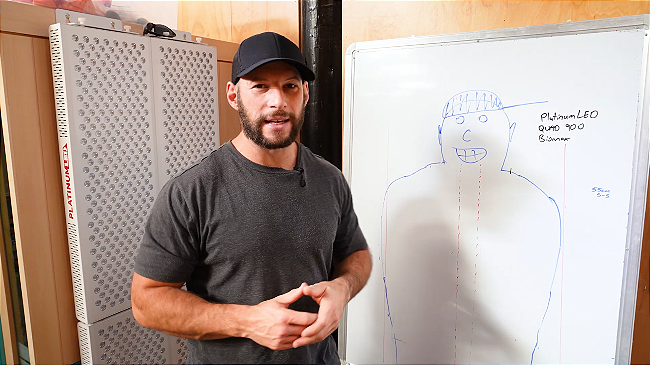
What the Numbers Reveal About Red Light Therapy Panel Performance:
When choosing a red light therapy panel, one of the most important factors is how the light spreads and the strength of the irradiance (power output) at different distances from the panel. The tests I ran on the PlatinumLED Biomax 900 quad setup revealed valuable insights.
My BioMax 900 is an older generation panel.
Testing at 6 Inches: High Power but Uneven Coverage
At 6 inches from the panel, the peak irradiance was 84 mW/cm², which is a strong power output; however, the light spread wasn’t as even as I had hoped. Here’s how the numbers break down:
- Peak irradiance: 84 mW/cm² right in the center of the panel.
- 80% drop-off point: The light intensity dropped to 67 mW/cm² just a few inches from the center.
- 50% drop-off point: The irradiance at 50% (half the power output of the center) was near the edge of the LED panel.
- 25% drop-off point: The irradiance at 25% was just inside the panel’s edge.
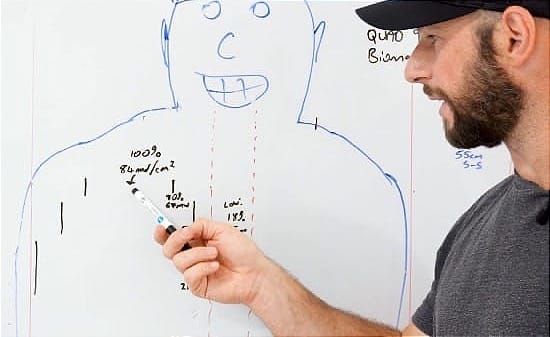
The most interesting number was the irradiance between the four panels without LEDs. The irradiance dropped to 18% of the peak, or about 15 mW/cm².
What does this mean?
If you’re standing 6 inches from the panel, you’re getting very concentrated light right in the middle of your body, particularly across the chest. But there’s a significant drop in power between the panels, meaning you’re not getting an even distribution of light across your entire body.
For instance, the irradiance in the middle of your chest might be intense, but further out towards your arms and shoulders, it’s significantly less.
Testing at 12 Inches: Improved Light Spread:
At 12 inches away, the light coverage improved dramatically. Here’s the breakdown:
- Peak irradiance: 71 mW/cm² in the center of the panel—slightly lower than at 6 inches, but still powerful.
- 80% drop-off point: The irradiance at 80% of the peak was much better spread across the face of the panel. It covered 80-90% of the LED surface, significantly improving.
- 50% drop-off point: The irradiance at 50% extends beyond the panel itself, meaning the light spreads more evenly across your body.
- Lowest point (between panels): The irradiance between the panels was only 40% of the peak or 28 mW/cm². This is a significant improvement from the 18% at 6 inches.
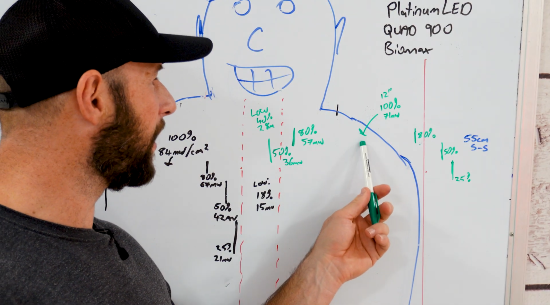
Although the peak irradiance is lower at 12 inches than at 6 inches, the overall light coverage is significantly superior. The gap between the panels is less of an issue, and the light spreads evenly across your chest, shoulders, and upper body.
Key takeaway at 12 inches:
The light coverage at 12 inches is much more balanced than at 6 inches. While you’re still getting strong irradiance, the light spreads evenly across your entire body, and the gaps between the panels become less noticeable.
Testing at 24 Inches - Further Improvement in Light Spread:
The irradiance continued to drop slightly at 24 inches from the panel, but the light spread was even better. Here’s how the numbers look:
- Peak irradiance: 61 mW/cm² in the center of the panel.
- 80% drop-off point: The light spread was slightly wider than 12 inches, as expected when moving further from the panel.
- Lowest point (in between panels): The irradiance between the panels at 24 inches was still 72% of the peak. This means the light was quite strong in the gaps between the panels, at 44 mW/cm².
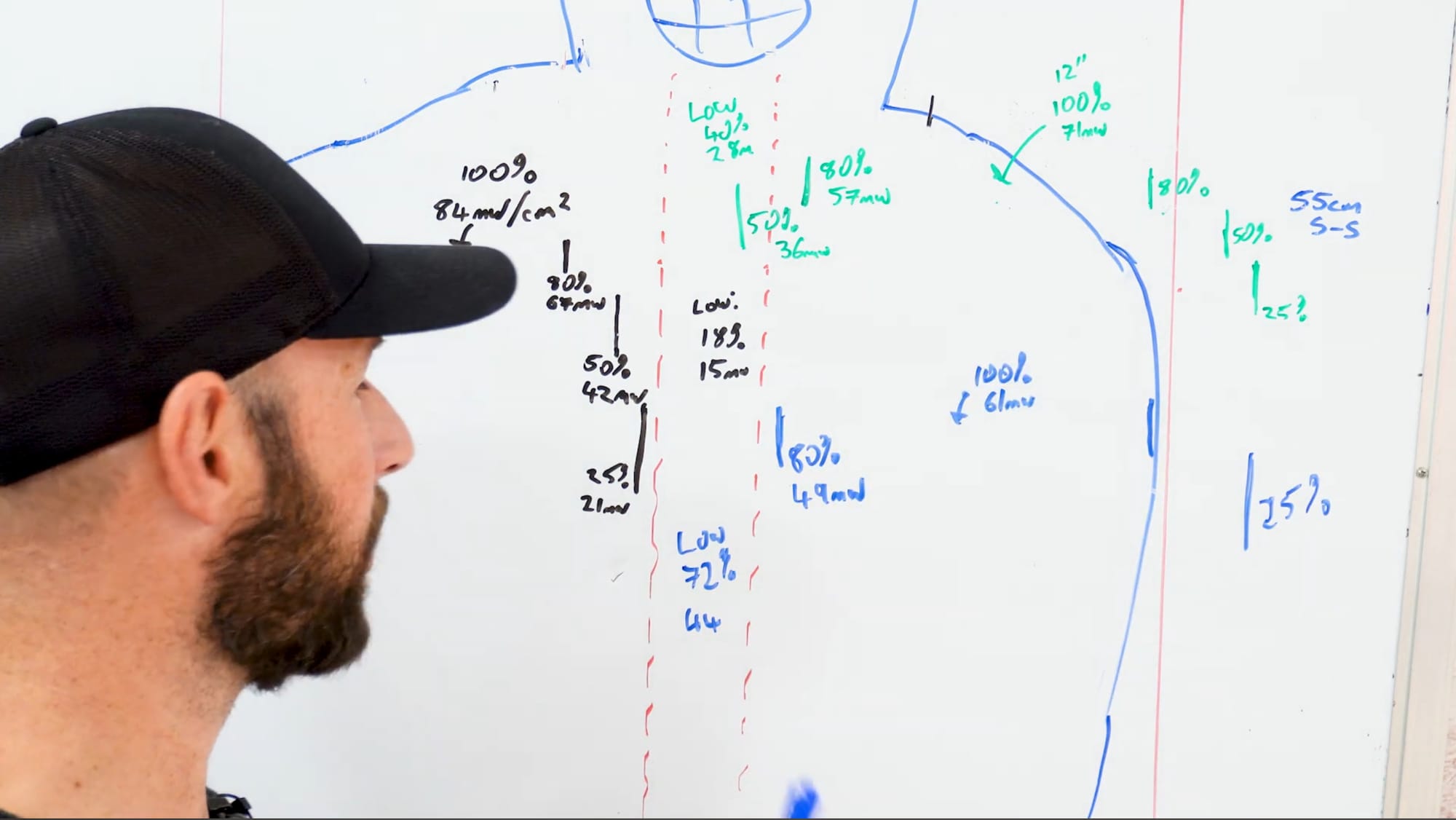
Interestingly, the lowest point in the middle of the panel (where the LEDs don’t overlap) had a relatively high irradiance—72% of the peak. This is a significant improvement over what we saw at 6 inches.
Key takeaway at 24 inches:
The overall light distribution is the most even at 24 inches. While the peak irradiance is lower than 12 inches or 6 inches, you get consistent light across your entire body, including in the gaps between the panels. Standing 24 inches from the panel yields the most balanced results, providing full-body coverage with no weak spots.
Comparing the Three Distances: What Does It All Mean?
- At 6 inches, the light is powerful but concentrated in the center. There’s a sharp drop in power between the panels, so you might not get as much light on your sides or extremities.
- At 12 inches, the light coverage improves significantly. You still get good irradiance, but the light spreads evenly across your body, reducing the weak spots between panels.
- At 24 inches, the light distribution is the most even, but the irradiance is lower. However, even at 24 inches, the power output is still strong enough to provide therapeutic benefits.
Understanding the Polka Dot Effect and Hot Spots:
One interesting observation from my previous testing with the Platinum LED Biomax 900 is the “polka dot effect” or “hot spots.” This is where you get concentrated light in certain areas (usually directly in front of the LEDs), with significant drop-offs in between. This effect is most noticeable when standing close to the panel, like at 6 inches.
However, the further away you move from the panel, the more the light blends, and the polka-dot effect disappears. To avoid these hot spots and achieve a more consistent dose of red light therapy across your body, consider standing further back, at a distance of between 12 and 24 inches.
Should You Stand Further Away From Your Red Light Panel?
Based on these results, standing further away from your red light therapy panel can improve light spread and reduce weak spots in coverage. Although 6 inches may provide more concentrated light, it won’t ensure even coverage, and you’ll miss out on benefits if certain body regions aren’t fully exposed.
If you aim for full-body treatment—shoulders, chest, neck, arms, and beyond—standing 12-24 inches away is your best bet. You’ll still get strong irradiance, but the light will spread more evenly, covering more surface area with fewer gaps.
Thoughts: Do Numbers Guide Your Decision?
Understanding the irradiance numbers and light spread at different distances can significantly affect your red light therapy results. Whether treating specific areas or seeking full-body coverage, knowing how far to stand from your panel and the size of the panel you need is essential.
As tested here, the Platinum LED Biomax 900 quad setup demonstrates that light spread and coverage improve as the distance from the panel increases. While standing close provides a more intense treatment to specific areas, moving back offers more even light distribution across the entire body.
For optimal results, consider using a more extensive panel setup, such as the Biomax 900 quad, and position yourself at least 12-24 inches away for maximum coverage and therapeutic benefits.
Final Thoughts: Do You Need More Panels?
Now that I’ve shown you these results, I’m curious—does this change what you were considering buying? Will you need more panels, or are you reconsidering the size of the panel you want?
Remember, even smaller panels offer systemic benefits, so if you’re on a budget, don’t worry! With a smaller panel, you can still gain significant health improvements from red light therapy, even if it doesn’t completely cover your entire body.
Full-body coverage is vital for those seeking maximum benefits, and standing further back from the panel ensures a nice, even spread of therapeutic light.
Here's my breakdown of the best red light therapy wall panels.
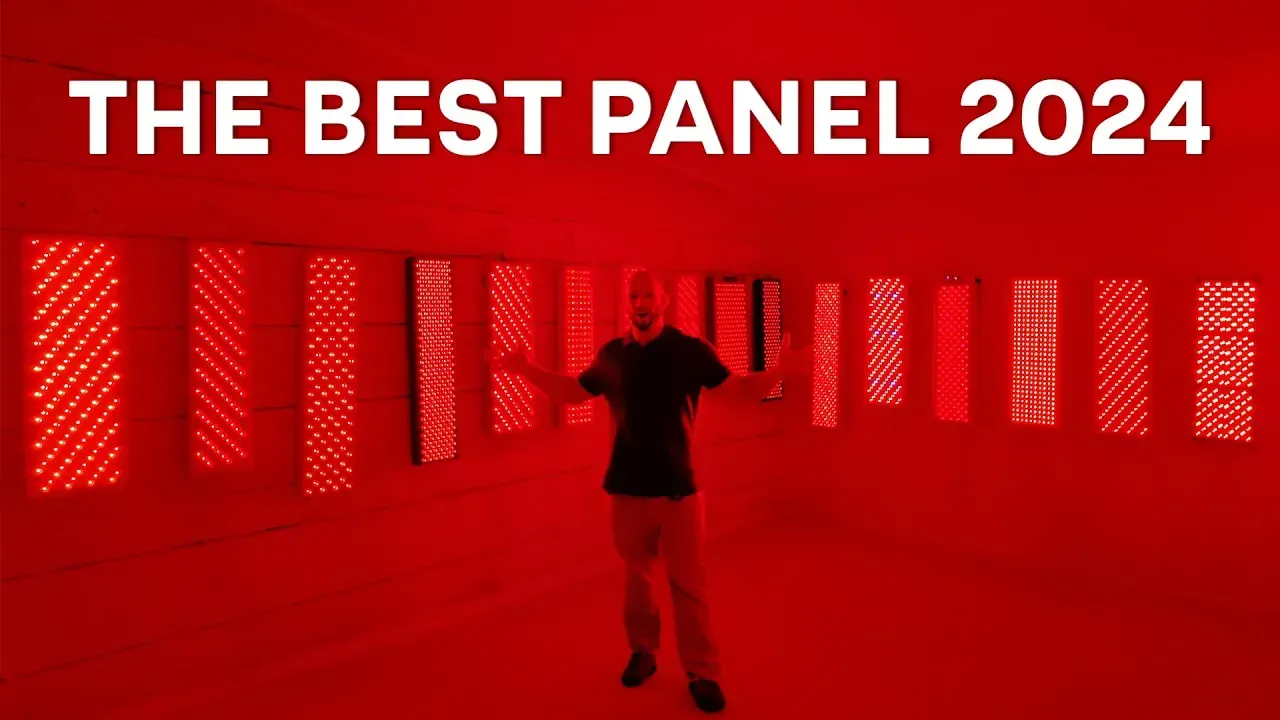
Here is my Best Body Panel article. The Block Blue Light XXL is now available!
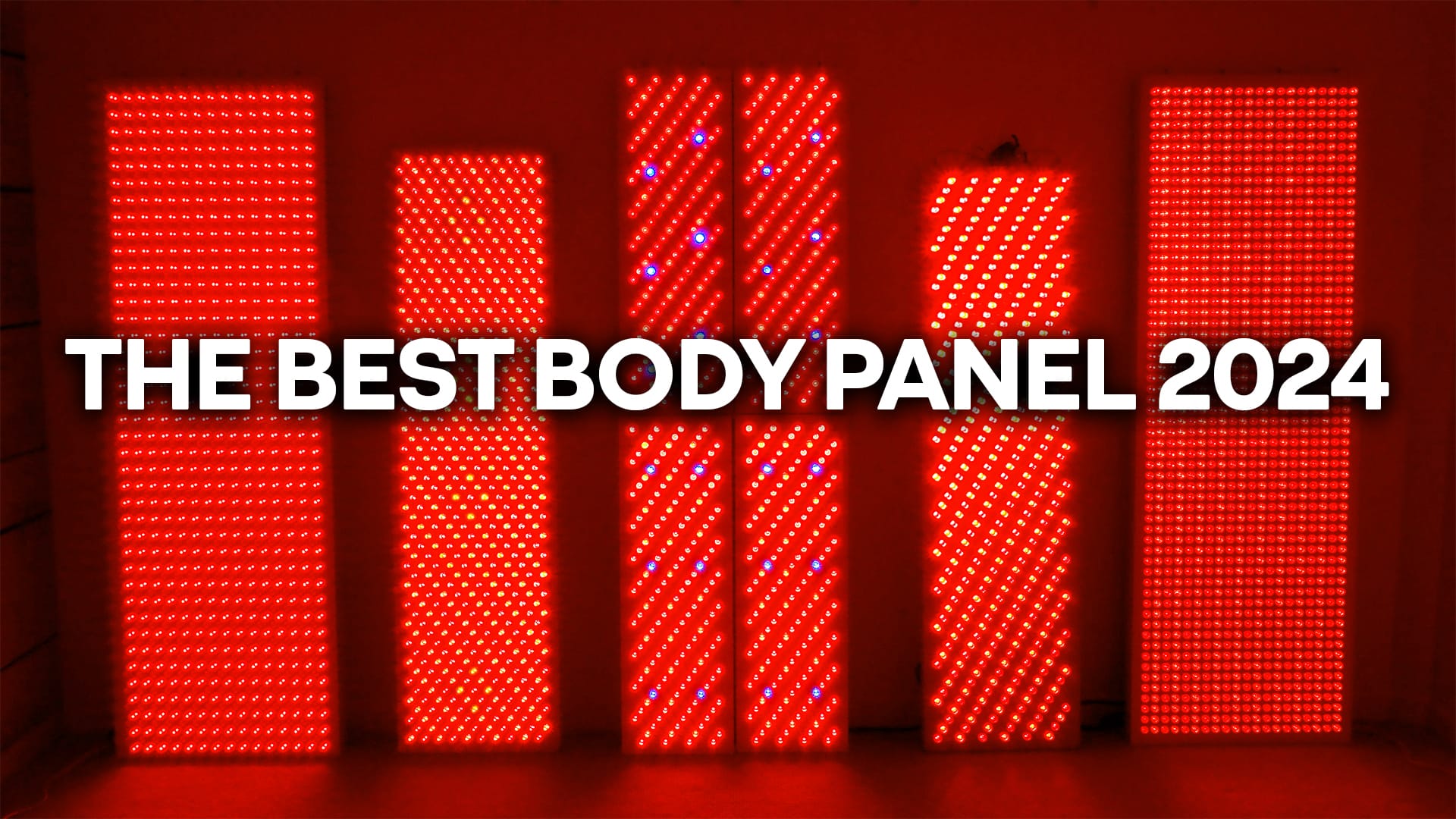
Items mentioned in these Articles:
✅ For a Mito Red Light Panel - use this link: https://aferg.co/7d221 - A discount is automatically applied after you click the link
✅ For a PlatinumLED panel use the following link: https://aferg.co/redled The discount appears in a popup window once you click the link.
✅ For a Rouge Pro, use discount code ALEX and this link: https://aferg.co/rougecare
Consider These Reviews:
🔴 PlatinumLED Biomax Vs Block Blue Light Mega: BIG Battle
🔴 Mito Red MitoPRO Mega X Review: Decent Option BUT...
🔴 Block Blue Light Elite XL: Consider THIS Before You Buy!
🔴 Rouge Ultimate G3 Review: BIGGEST Panel I've Tested!
🔴 Rojo Refine 3600: Perfect Panel, Or Not!?
Found This Interesting? Look At These Articles:
🔴 Red Light Therapy For Eye Health: The Very Impressive Science
🔴 Red Light Therapy Wavelengths Benefits: The Ultimate Guide
🔴 Is Red Light Therapy Science-Based? An Introduction
🔴 The Remarkable Role Of Light Therapy In Periodontal Care
🔴 Red Light Therapy For Neuropathy: The Promising Science
Alex Fergus wrote this blog post. Alex is an ISSN Sports Nutrition Specialist, Fitness Professional, and certified Superhuman Coach who continues to expand his knowledge base and help people worldwide with their health and wellness. Alex is recognized as the National Record Holder in Powerlifting and Indoor Rowing and has earned the title of the Australian National Natural Bodybuilding Champion. Having worked as a health coach and personal trainer for over a decade, Alex now researches all things health and wellness and shares his findings on this blog.
